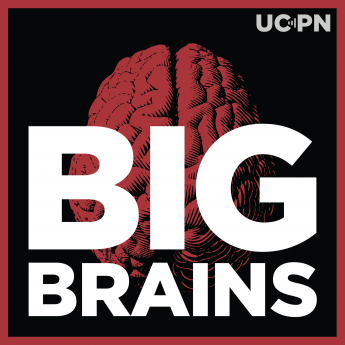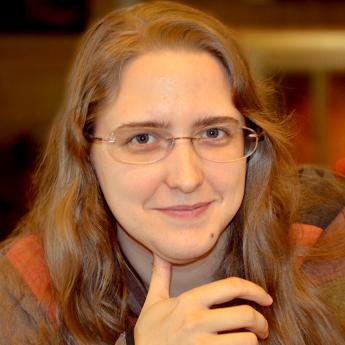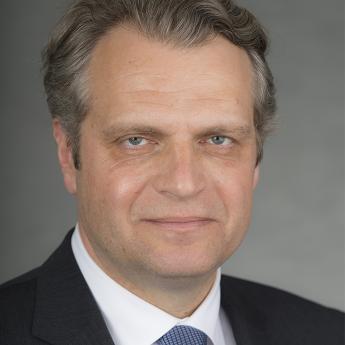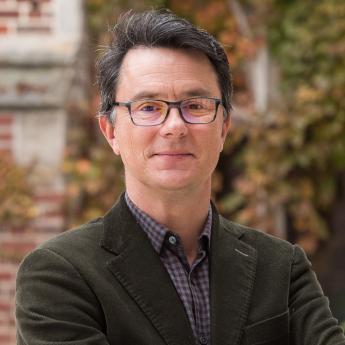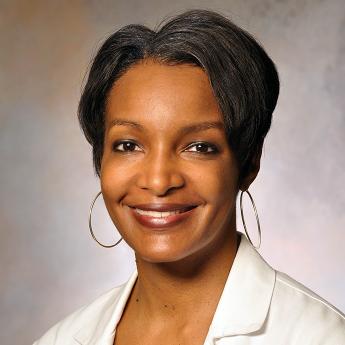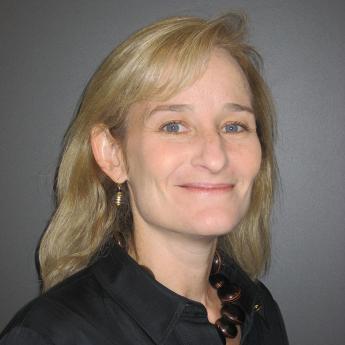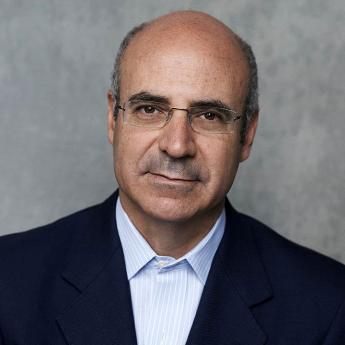Show Notes
Since the late 1800s, if you were serious about studying biology, you went to the Marine Biological Laboratory. The discoveries made there have led to world-changing applications in biology, medicine and neurology.
Its recently appointed MBL director, Nipam Patel, knows a lot about studying organisms. As one of the world’s leading evolutionary and developmental biologists, his work has helped us better understand why it matters to study a diversity of life.
Recommended:
- Video: Meet Nipam Patel, director of the Marine Biological Laboratory
- Nipam Patel appointed director of the Marine Biological Laboratory
- Mail-Order CRISPR Kits Allow Absolutely Anyone to Hack DNA—Scientific American
- Live Imaging Using Light-Sheet Microscopy—The Scientist
- The Revolution Will Be Edited—Discover Magazine
Transcript
Paul Rand: The MBL, part of the University of Chicago, is an important place. The history and work being done there are almost mythical to many scientists. It was that significance that convinced one biologist last year to leave his professorship on the sunny west coast, and become the Director of the laboratory.
Nipam Patel: I honestly had no thoughts of leaving my position at UC Berkeley. I'm was very very happy there. But this was something very special.
Paul Rand: That’s Nipam Patel, one of the world’s leading evolutionary and developmental biologists. Like many scientists at the MBL, he’s spent his career studying how organisms develop.
Nipam Patel: My background is really in trying to understand embryonic development. So how do you go from a single cell into a complicated multicellular organism.
Paul Rand: The work Patel and the Marine Biological Laboratory has done teaches us all sorts of things about why organisms are the way they are and why it matters to study a diversity of life beyond just humans. The possible applications of his discoveries, and many of the discoveries at the MBL, could reshape our world in stunning ways.
Nipam Patel: It's very basic research that is applicable to thinking about everything that goes on in humans in terms of gene interaction and patterning morphology what goes wrong when these genes are not expressed inappropriately.
Paul Rand: From The University of Chicago, this is Big Brains. A podcast about the pioneering research and pivotal breakthroughs reshaping our world. On this episode, this importance of studying a diversity of life with Nipam Patel and the Marine Biological Laboratory. I’m your host Paul Rand.
MBL TAPE: From the functions of a single cell to the health of our entire planet the MBL is helping to unravel the mystery’s of life and ensure it’s survival for generations to come.
Paul Rand: Nipam Patel’s road to the Marine Biological Laboratory is paved with incredible discoveries about all sorts of organisms. Before that work would lead him to become the director of the MBL, he was obsessed with a single question biologist have been trying to answer forever. Why do organisms develop the way they do?
Nipam Patel: So I was in a relatively early wave of people who were using new techniques to answer questions about the evolution of development. So the basic idea is that you can understand the development of a given creature. And so a model system like drosophila melanogaster or the fruit fly or sea elegans or the nematode worm, and you could understand the mechanisms that were in play there. But one of the fascinating questions is will how would you change that to make slightly different organisms. And that was this whole field of Evo Devo is to try to understand how development evolves.
Paul Rand: So that’s what you call it in the field Evo Devo?
Nipam Patel: Yeah, Evo Devo
Paul Rand: Sounds like a rock band.
Nipam Patel: Yeah, so that’s something I got excited about.And the particular question I was asking is how you make segments of repeating patterns in animals and I was really fascinated by trying to understand questions about how they got the right legs on the right segments
Paul Rand: Leg for jumping versus a claw.
Nipam Patel: Exactly.
Paul Rand: Confused? Think of it like this: have you ever wondered to yourself why exactly your finger are where they are on your body? What are the mechanisms inside you that said, okay the toes goes here, the fingers go there? And the organism Patel turned to in order to find answers about how organisms build these models: crustaceans.
Nipam Patel: The things that people will be most familiar with are the ones they eat: so lobsters, crabs, shrimp but they're actually huge variety of species and morphology body plans to them. And I could read in textbooks that there were all of these interesting looking crustaceans right. But the question was, well where do I get my hands on animals and more importantly how do I get my hands on embryos for these things.
And so it was at that time there was a graduate student in the lab named Bill Brown, and he went to the Shedd Aquarium here in Chicago and he went looking around for a crustaceans that we might work on. And the thing that he did that was wonderful was that he went to the filtration system of the aquarium and fished out these amphipods that we work on now, parhyale, from the filter system of the Shedd Aquarium. And so that actually makes them a really good lab animal because no one takes care of them they just eat the garbage that comes in and they do perfectly fine
Paul Rand: And it made a great species.
Nipam Patel: It made a great species.
Paul Rand: And you call them parhyale?
Nipam Patel: Yeah. Their common name is a beach scud.
Paul Rand: It sounds like a really attractive creature.
Nipam Patel: Well if you're anywhere in the world on a beach and there's seaweed or something like that and you see the little grey things hopping through the air and through the sand it's this group of animals, they're called amphipods.
And then the big breakthrough was where we figured out how to inject them, how to mis express genes in them ,how to knock genes down and that took decades of work basically. Now we have a system where \we have the genome sequenced, we have the transcriptome. we know all the genes that are being expressed at different stages, and then we can look at where they are expressed. We can come up with ideas about what those genes might do based on what's known in other organisms and where they're expressed in parhyale. So we can go in when the embryo is one or two cells we can inject it and then very efficiently knock out the genes that we're interested in and then ask what goes wrong with the embryo.
Paul Rand: So there’s some real, as I understand, for lack of a better word, applications that start coming out of these things that when you start thinking about actually human being…medicine…
Nipam Patel: So one of the areas that we're interested in is again how you get the right kind of limb on the right segment. So what we've done is, we’ve looked at a set of genes that are well known in many animals to control the body plan, controlling what morphology you have on what segment. And the fascinating thing about these genes is that they're actually conserved in all animals. So they’re in humans as well.And they do that same function. So for example, if you look at the vertebrae in your backbone, you have different kinds of vertebrae in different segments.
Paul Rand: Each one with a purpose.
Nipam Patel: With a slightly different purpose. And related to that purpose is they have slightly different morphologies. So, for example, your thoracic vertebrae have ribs on them to protect your internal organs.
Nipam Patel: And it turns out that the genes we study that affect body plan in parhyale are the same ones that are used in humans to pattern their body. And if things go wrong with those genes, for example, there's a couple leukemias that are actually linked to inappropriate expression of these genes. And in that regard, it's very basic research that is applicable to thinking about everything that goes on in humans in terms of gene interaction and patterning morphology what goes wrong when these genes are not expressed appropriately.
Nipam Patel: I can give you another potentially exciting example where we studied early lineages in the embryos or different cell types that get established in the early embryo. At the eight cell stage there's two of those cells that go on to make all the muscles, for example. There's another cell that goes on to make the gut. There's three cells that make all of the covering of the animal, the ectoderm, the skin of the animal. But we discover that there is one cell at the cell stage that's set aside to be the germ line of the animal. So that's the cell that's ultimately going to give rise to the sperm and egg and then be the next generation. And one of the things that people have always studied is this separation between what they call the germ line and the soma, so the cells that make the sperm and egg and the next generation and then everything else that makes all of the parts that in fact don't go to the next generation. Right. What we discovered in parhyale is that there's this one cell that if you kill it then when the animal hatches it doesn't have a germ line right.
So it doesn't have the cells it would normally use to make sperm and egg as an adult, but as an adult it's almost always fertile. And so it's able to regenerate its germ line. And so that, of course, has the potential to have a lot of really interesting applications. But the other thing is that we're beginning to wonder whether it's not actually all that unique. There are hints that other animals can do this as well. And, again, it's a nice example where our models species that we usually focus on, they can't do that but that doesn't mean that everything can't do that. And so then it becomes really exciting to focus on animals that that can do this and ask, so what is the mechanism that they use to do that and can we apply it to humans right and say OK if there is a problem with the germ line in humans. Is there a way for us to regenerate a new germline. And this really highlights the need to be able to work on many many more species because the biology is actually a lot more complicated than of course we'd like it to be. It’s also just fascinating cause we can think about, in evolution, how did you get all that variety.
Paul Rand: Patel would work on a whole host of different species. But his discoveries with one other particular creature would gain him the most notoriety. It’s an insect that captures the imagination of humans both young or old: butterflies. That’s coming up after the break.
(CapitalIsn’t Break)
Paul Rand: Before Patel was the director of a leading biological institution, he was a kid just like everyone else. And it was one fateful moment in his childhood that would instill a powerful curiosity about life on our planet and lead him down the path of evolutionary biology.
Nipam Patel: So I grew up in an El Paso, Texas. And I was about eight and I actually found a dead butterfly in the yard.
Paul Rand: And are these monarchs?
Nipam Patel: No, it was a tiger swallowtail, it was a western tiger swallowtail so volatile. And it was a very nice specimen and I have no idea how it died. It was just lying there in the yard. And so I brought it I,n and I read up in a book how to mount it, and the next thing I knew I was like convincing my mom to sew a butterfly net for me. And I started collecting and my parents actually built a cabinet and on the wall of our living room for me to display my butterflies in andthat first butterfly is actually still sitting in a case in my parents house in Colorado.
So I've always really been fascinated by butterflies and what happened though is while I was working on the crustaceans and other insects, I really wasn't working scientifically on butterflies in terms of my research program. But I'd always wanted to and I knew quite a number of the scientists that were doing really interesting things in a modern era of genetics and developmental biology and butterfly. But the thing that I decided I could approach was an issue of what's called structural color.
So many of the colors you see in butterflies like yellow, red, brown, black these are primarily made by pigment.So small molecules that are inside the scales of the wing absorb certain wavelengths of light, and then those wavelengths that come back at you give you the perception of color. So that's how all the dyes that color your clothing work. They’re pigment molecules that absorb light and then what wavelengths are left is what your eye sees and then that gives you the perception of color. But for blue and green, in many organisms and particularly in butterflies, they are not usually made by pigment molecules. They're instead made by nano-structures. So very very thin. And the idea is that's just approaching a half wavelength of light. So it's that small. And when light does that, interesting things happen to light.
So a really good illustration of this is a soap bubble. So you think, well soap doesn't have any color, but if you look at a soap bubble it's like the colors of the rainbow. So why is that. And that's because it's become a very thin film and light is bouncing off both the top and the bottom surface of the film but it's so thin that the light waves can then interfere with one another when the two reflections come together and they can interfere to make the color look brighter or they can interfere to make the color look dimmer. And that interference is going to be dependent on the thickness of that material and the wavelength, the color of the light that's interacting with it, and also something called the refractive index of the material. But the bottom line is using that kind of trick you can make materials that then give a particular color with they're doing is they're diminishing certain wavelengths of color and then making others much brighter.
Paul Rand: Just like with the crustaceans, there are some really fascinating applications to the work Patel has done with butterflies.
Nipam Patel: So the idea is we want to understand the basic biology, but the people who work on these colors, they’ve thought of some really interesting applications for this stuff. So, for example, because it's this nano-structure, pigments have a tendency to fade over time. So if you think about like the paint on your walls or something like that, if sunlight hits them for extended periods of time the colors fade. But the beauty of nano-structures is that they're not actually going to fade in that same way. So they're this sculpted material and as long as that material stays intact it's going to interact with the light in the same way and give a color. So there is some interest in actually using materials like this to make paints or to make coatings that basically don't fade sunlight.
Paul Rand: We’re going to call Sherwin Williams as soon as we’re done..
Nipam Patel: Yeah. And then there are other really interesting applications. People have been excited to use particular nano-structures to deliver drugs for example. People have thought of ways that you could make currency so it couldn't be counterfeited.
Paul Rand: Wow.
Nipam Patel: The problem is that when you go and try to make these nano-structures using manmade techniques. it's not that easy to do. It's expensive, it requires harsh conditions depending on the things you're trying to make. So our take on this is, well we don't know how the butterfly makes this. And of course the butterfly does it you know naturally. Right. And so what we as developmental biologists are really interested in is so how does a butterfly do this. And it's really a single cell, the unit of structure on here are the scale cells that grow on the wing. And it's those individual cells that make these nano-structures to make the color.
Okay. So you have defined the structure and you know how it works, but how do you build it? How does the butterfly build it? And that becomes a really interesting challenge because you're asking to look inside a pupi of a growing butterfly, and then to image something which is smaller than the wavelength of light so by definition can't be viewed with light itself in terms of its structure. So we've been developing new techniques to window into the pupi to watch the wind develop. We've been developing ways to watch components of the scale as it's growing and living butterflies. And so that's been ongoing work. So again this was a project I kind of was fiddling with in the lab.
Paul Rand: And then you're started at Berkeley and you’re bringing it to the MBL.
Nipam Patel: Yeah.
Paul Rand: Which brings us to the Marine Biological Laboratory. Similar to the discoveries and applications from Patel’s crustaceans and butterflies, the work that’s being done and has been done on organisms at the MBL could change all sorts of things about our world. Those possibilities, after the break.
(Graham School Break)
Paul Rand: Nipam Patel took over as director of the Marine Biological Laboratory in 2018 to lead the institution into the next stage of it’s evolution. But to really understand the MBL, you need to understand it’s history, and that story looms large over the fields of biology, medicine, and neurology.
MBL TAPE: “For more than 100 years scientists have been coming here to study the marine organisms found in local waters. The MBL opened its doors in Woods Hole in the summer of 1888.”
Nipam Patel: So it's founded in 1888. So it’s a very old institution.And it has been for a long long time an incredible turn of scientific ideas. There is some work that's gone on at the MBL which is directly related to huge advances in biology. And those are things that have led eventually to Nobel prizes.
MBL Tape: “More than 50 Nobel Laureates have spent a season or more at the MBL as students, faculty or researchers. Alumni comprise a biology hall of fame. Jacques Loeb discovered reproduction using an unfertilized egg. Ernest Everett Just pioneered research methods on the embryology and physiology of egg cells. Thomas Hunt Morgan discovered the role of genetic factors in inherited characteristics. The MBL’s Nobel tradition continues as it plays a significant role in training the world’s leading experimental biologists.”
Paul Rand: Perhaps the most famous discovery made at the MBL is something called the giant squid axon. That’s a giant axon from a normal squid, not the axon of a giant squid, I made that mistake to…
Nipam Patel: No. So it's not a giant squid. It's a giant squid axon. So it's the the axon is really huge in the squids.
Paul Rand: And tell me again what the axon is
Nipam Patel: So it’s a giant nerve fiber.
TAPE: In the 1930s the British zoologist, professor J.C. Young was engaged in a study of the squids anatomy. Young observed an array of large tubular structures. From their similarity to surrounding nerve fibers, Young thought they must be single neurons. Giant axons that transmitted nerve impulses from a concentration of nervous tissue to the mantel muscles.
Nipam Patel: So it turns out that there is a giant axon that exists inside of squid that then powers the mantle sends the signal to you know for the propulsion.
TAPE: Using electrodes, he stimulated the surrounding nerve fibers and found that he could only produce large muscle contractions in the mantel when the large turbual structures remained intact. So these were indeed giant axons.
Nipam Patel: And that axon, I believe it's about a thousand times wider than a normal human Axon.
TAPE: Scientist quickly appreciated the significance of Young’s finding. For here at last was an axon large and robust enough to investigate with the techniques available at the time, and one that survived for several hours when separated from the nucleus.
Nipam Patel: So that means that you can squeeze out the components, you can do all sorts of experiments. So there were classic experiments that led to the discovery of ion channels and how they work that was done with these squid giant axon.
Paul Rand: And when was this.
Nipam Patel: This was early on.
Paul Rand: But this led to major science advances in neurological systems of human beings.
Nipam Patel: Yeah absolutely.
Tape: Research on the giant squid axons unraveled the mechanisms of the formation and propagations of the nerve action potential. This understanding led directly to the development of drugs that block action protentional formation and so act as local anesthetics now used routinely as pain killers in dentistry and minor surgery.
Nipam Patel: And so to this day it's still a great preparation for all sorts of experiments like actually understanding even other basic questions like the motors that move proteins and other cargo through the axon. One of the fascinating things with cephalopods in general, so that's the group that includes squid, cuttlefish and octopus, is that they’ve evolved very sophisticated brains. Right. So they have fairly complicated behaviors and memories and things like that. And people are really fascinated by that because it's an independent evolution of a complicated brain that's very different than the evolutionary process that led to the brains that we have and other vertebrates. And so it's kind of a great opportunity that says well if you could replay the tape of life again and you would evolve a complicated nervous system how would you do it. And so you actually have that experiment already run because it's led to a fairly sophisticated nervous system in cephalopods. And so there is a great interest in saying, okay well let's try to understand the cephalopods brain because then we could understand basic principles of organization because it's done in a very different way with a different architecture but it's achieved sort of the same end result.
Paul Rand: To this day, there seems to be a groundbreaking discovery happening every month at the MBL. In March of 2019, scientists announced a big breakthrough in understanding how squids use specialized organs in their skin to change their color. That work brings bio-engineers much closer to designing smart skin, a material or wearable device that could change color very quickly. And the previous month, a different group of researchers took a major step forward in the field of body regeneration by studying a tiny little eel.
MBL Morgan: Our main model organism is the lamprey which looks like an eel but is a fish. And the lamprey is really cool because it’s a very primitive vertebrate. It evolved 550 million years ago. And even though they’re so primitive and so old in evolutionary terms it turns out they have brain and spinal chord structures which are very similar to the ones we have.
Paul Rand: That’s Jennifer Morgan, the senior author of the eel regeneration study, and Director of the MBL’s Eugene Bell Center for Regenerative Biology and Tissue Engineering.
MBL Morgan: Unlike humans, if you sever the spinal chord of a lamprey, without any treatment or intervention whatsoever, you can put the animals back in the tank and over the time course of three months they’re able to regain their ability to swim. The real question is, if they can do it, why can’t we?
MBL Audio: The remarkable thing we found is that lampreys are turning on genes that promote growth in the peripheral nervous system of humans. That tells us that there is an evolutionary conserved program that’s able to drive nerve regeneration from this primitive lamprey all the way to humans, and if that’s the case, if we could figure out how turn that on for humans in the spinal chord or in the brain, we might have better outcomes in the clinic.
Nipam Patel: There is a lot of interest in studying regeneration particularly in marine organisms are very good at doing it to ask how can we get insights into how we could apply that to human.
Paul Rand: That area absolutely fascinates me. Do you ever see a period in time where we'll learn enough that a human can actually regenerate a limb?
Nipam Patel: That's a great question and I don't know.I think that I'm hoping that that becomes true that we understand enough to we might not able to regrow a whole arm but we'd be able to do things like to fix nerve damage or you know an injury and things like that. Whetheror not you could actually take an adult and regrow a whole arm I think it's probably not so likely for a variety reasons. But who knows. A lot of things in biology that we thought were impossible turn out to be so.
Paul Rand: As you’ve heard…it can be crucial for us to study a diversity of life, not just humans. That concept is something Patel and everyone at the MBL hold close to their heart. In this era where it seems like all our focus is on researching new technologies…it’s important to remember that we still have a lot to learn from the organic life all around us.
Nipam Patel: So we're we're actually pushing on developing quite a number of new animal models so the rationale is like I mentioned with Pala and the same with the butterflies is that there's a whole lot of interesting biology out in the world that we don't study because we we may know the organisms in some cases but we don't really have the tools to study them in depth.
Nipam Patel: And so what we like to do at the MBL is with a strong focus on marine organisms in particular is to develop an increasing number of species where not only do we understand the husbandry of it but we develop the tools so that people can go in and do things like genetic manipulations and things like that. So we would leave it to the community to decide on what the most exciting questions are. But then we would have the resources for them to go and do it right.
Episode List
What Historic Pandemics Could Teach Us About Coronavirus, with Ada Palmer (Ep. 48)
A historian explains what we can really learn about COVID-19 from the Black Death pandemic
A Crisis Management Expert’s Advice on Handling Coronavirus, with Daniel Diermeier (Ep. 47)
A world-renowned scholar gives advice to business and political leaders on handling the COVID-19 pandemic.
How Students and Schools Can Recover From Coronavirus, with Elaine Allensworth (Ep. 46)
A leading education expert discusses how families and teachers are adjusting to remote learning.
Trump, Coronavirus and the Cost of Ineffective Government, with William Howell (Ep. 45)
Leading presidential scholar thinks coronavirus has revealed why our governmental institutions need to be reformed.
How Coronavirus Is Exposing Our Racial Disparities, with Monica Peek (Ep. 44)
Dr. Monica Peek was studying racial health disparities before the coronavirus outbreak. Now her research is more important than ever.
Coronavirus Shows Why We Need To Rethink Health Care, with Katherine Baicker (Ep. 43)
Leading UChicago health economist explains why our public health infrastructure wasn’t ready for coronavirus, and what we need to change for the next pandemic.
What Rats Can Teach Us About Empathy and Racism, with Peggy Mason (Ep. 42)
What can rats teach us about empathy? As one University of Chicago neurobiologist discovered, we can learn from them a lot.
Why the coronavirus could send China’s economy back to the ‘80s, with Chang-Tai Hsieh (Ep. 41)
A University of Chicago economist explains why the coronavirus is one of the most pivotal moments in China’s economic history.
Why the Doomsday Clock is Closer to Apocalypse Than Ever, with Rachel Bronson (Ep. 40)
Even though the Doomsday Clock is a symbolic metaphor, understanding the meaning behind it is a matter of life and death.
Vladimir Putin’s No. 1 Enemy, with Bill Browder (Ep. 39)
What turned a powerful businessman into an international advocate for human rights.

